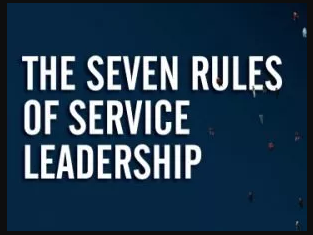
If your company is going to pursue building an uplifting service culture, leadership must initiate and support the process. But service leadership must be extended and ultimately embraced at all levels of the organization. Let’s take a closer look at how to lead from all levels.

Top-Down Service Leadership
In the first model, a service culture initiative gets a great start. The leader from the top becomes a role model for, and communicates with, everyone else in the organization.
However, this model alone is not enough because if even one manager in the middle doesn’t set the right example or communicate the right service vision, a lot of employees are left behind. It’s also not enough if anyone thinks that uplifting service or changing culture is a job for the people at the top. It’s not. Uplifting service is everyone’s job.
Bottom-Up Service Leadership
There are instances where frontline employees have initiated service revolutions— and have created award-winning service cultures. Consider the Pike Place Fish Market in Seattle, Washington. The company’s leaders did not come to work one day and ask employees to throw and catch fish across the stall to give its customers an award-winning show. The employees came up with this idea themselves, and they enthusiastically put it into action. But bottom-up service leadership typically doesn’t happen, because frontline employees often aren’t educated, enabled, or empowered to be proactive with new ideas for better service. Most simply follow procedure. But a frontline employee can take the lead—with a customer to produce a better outcome, or with a colleague to create a better mood. A frontline supervisor can lead by encouraging, coaching, and training on the job. A manager can lead by reaching out to help colleagues in other departments, making service come alive inside the organization.
Leading from Every Position
Leading service from all levels means that every employee takes personal responsibility for providing better service in every situation his or her position empowers him or her to reach. Service leadership may be initiated from the top, but it is also embraced at the bottom and is encouraged and enabled everywhere in between. You don’t need an important title to be a service leader. It’s a responsibility you can choose for yourself. When service leadership is alive at all levels in a large organization, frontline employees serve with passion because they understand the importance of their role, middle managers serve with passion because they understand the importance of their role, and senior leaders serve with passion because they understand the importance of their role. Indeed, it is everyone’s role to take the lead in building a service culture.
Start by leading from the top and build alignment with each other, embrace a common service vision and commit to take strong action as role models for superior service. Find out more at Engaging Leadership Teams.
NOTE: This article is a modified excerpt from the New York Times bestseller UPLIFTING SERVICE. Read Free Chapters Now at www.RonKaufman.com/Resources/.



